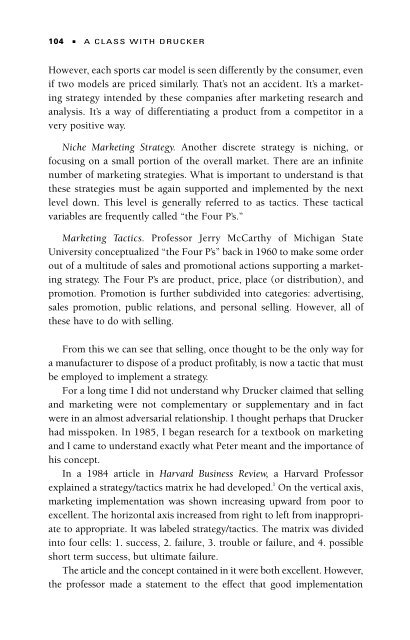A Class with Drucker - Headway | Work on yourself
A Class with Drucker - Headway | Work on yourself
A Class with Drucker - Headway | Work on yourself
Create successful ePaper yourself
Turn your PDF publications into a flip-book with our unique Google optimized e-Paper software.
104 ■ A CLASS WITH DRUCKER<br />
However, each sports car model is seen differently by the c<strong>on</strong>sumer, even<br />
if two models are priced similarly. That’s not an accident. It’s a marketing<br />
strategy intended by these companies after marketing research and<br />
analysis. It’s a way of differentiating a product from a competitor in a<br />
very positive way.<br />
Niche Marketing Strategy. Another discrete strategy is niching, or<br />
focusing <strong>on</strong> a small porti<strong>on</strong> of the overall market. There are an infinite<br />
number of marketing strategies. What is important to understand is that<br />
these strategies must be again supported and implemented by the next<br />
level down. This level is generally referred to as tactics. These tactical<br />
variables are frequently called “the Four P’s.”<br />
Marketing Tactics. Professor Jerry McCarthy of Michigan State<br />
University c<strong>on</strong>ceptualized “the Four P’s” back in 1960 to make some order<br />
out of a multitude of sales and promoti<strong>on</strong>al acti<strong>on</strong>s supporting a marketing<br />
strategy. The Four P’s are product, price, place (or distributi<strong>on</strong>), and<br />
promoti<strong>on</strong>. Promoti<strong>on</strong> is further subdivided into categories: advertising,<br />
sales promoti<strong>on</strong>, public relati<strong>on</strong>s, and pers<strong>on</strong>al selling. However, all of<br />
these have to do <str<strong>on</strong>g>with</str<strong>on</strong>g> selling.<br />
From this we can see that selling, <strong>on</strong>ce thought to be the <strong>on</strong>ly way for<br />
a manufacturer to dispose of a product profitably, is now a tactic that must<br />
be employed to implement a strategy.<br />
For a l<strong>on</strong>g time I did not understand why <str<strong>on</strong>g>Drucker</str<strong>on</strong>g> claimed that selling<br />
and marketing were not complementary or supplementary and in fact<br />
were in an almost adversarial relati<strong>on</strong>ship. I thought perhaps that <str<strong>on</strong>g>Drucker</str<strong>on</strong>g><br />
had misspoken. In 1985, I began research for a textbook <strong>on</strong> marketing<br />
and I came to understand exactly what Peter meant and the importance of<br />
his c<strong>on</strong>cept.<br />
In a 1984 article in Harvard Business Review, a Harvard Professor<br />
explained a strategy/tactics matrix he had developed. 1 On the vertical axis,<br />
marketing implementati<strong>on</strong> was shown increasing upward from poor to<br />
excellent. The horiz<strong>on</strong>tal axis increased from right to left from inappropriate<br />
to appropriate. It was labeled strategy/tactics. The matrix was divided<br />
into four cells: 1. success, 2. failure, 3. trouble or failure, and 4. possible<br />
short term success, but ultimate failure.<br />
The article and the c<strong>on</strong>cept c<strong>on</strong>tained in it were both excellent. However,<br />
the professor made a statement to the effect that good implementati<strong>on</strong>


